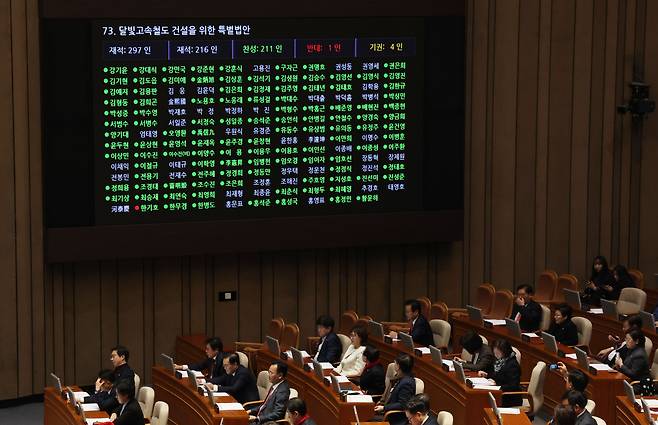Editorial: National Assembly neglects national interest by passing Dalbit Railroad bill
이 글자크기로 변경됩니다.
(예시) 가장 빠른 뉴스가 있고 다양한 정보, 쌍방향 소통이 숨쉬는 다음뉴스를 만나보세요. 다음뉴스는 국내외 주요이슈와 실시간 속보, 문화생활 및 다양한 분야의 뉴스를 입체적으로 전달하고 있습니다.

The bill, supported by 261 ruling and opposition party lawmakers, passed the plenary session of the National Assembly, marking the largest number of proposed bills submitted en masse in South Korean constitutional history. The legislation advocates for various benefits related to the construction of the “Dalbit High-speed Railroad” between Daegu and Gwangju. In response to criticism branding it as populist ahead of the elections, the initial bill removed terms such as ‘high-speed railroad’ and ‘double track line.’ Nevertheless, controversial clauses, including an exemption from a preliminary feasibility study for economic evaluation, were retained, leading to the passage of the revised version through bipartisan agreement.
The Dalbit High-speed Railroad project has been overshadowed in terms of efficiency and urgency compared to other regional railways. It was not even included in the preliminary draft of the ‘Fourth National Investment Plan for Railway Network’ announced by the Korea Transport Institute in 2021. However, the mayors of Daegu and Gwangju successfully secured its inclusion in national projects, leveraging the joint hosting of the Asian Games in 2038 as justification.
Approaching the general election, the mayors of the two cities announced a change in plans, shifting from a ‘single-track, conventional railway’ to an 11.3 trillion won plan for a ‘double-track, high-speed railway.’ Despite the proposed high-speed railway’s travel time being 84 minutes, it was revealed that even with high-speed operation on a conventional railway, the difference would be just 2 minutes. In response to criticism, lawmakers passed the bill, excluding only the terms ‘high-speed’ and ‘double-track,’ and disregarding other objections. The daily traffic volume on the Daegu-Gwangju highway (22,322 vehicles) is less than half of the national highway average (52,116 vehicles), indicating relatively low transportation demand. Nevertheless, the plan involves laying down railway tracks in this region.
Although the high-speed railway project, costing 11 trillion won, has been abandoned, the construction of a ‘single-track, conventional railway’ still requires 6 trillion won. If Daegu and Gwangju insist on a ‘double-track, conventional railway’ in the future, it would cost at least 8.7 trillion won. Among the 44 new projects included in the Fourth National Investment Plan for Railway Network, other projects are progressing through multiple feasibility studies. While other regions adhere to proper procedures for laying down railways, it remains unclear why only Daegu and Gwangju are exempted from preliminary feasibility studies for their projects, contradicting the principles of balanced national development. It appears to be nothing more than the political influence of these two powerful cities pushing through their agenda.
Copyright © 조선일보. 무단전재 및 재배포 금지.
- 어버이날 기념식 간 尹 “기초연금 40만원, 임기 내 인상”
- 대통령실 “수사 중인 사안을 언급하는건 부적절”
- 2022년 교포 목사가 300만원 가방 건네며 몰래카메라로 촬영
- 野의 특검 압박에… 이원석 “명품백 신속 수사하라” 직접 지시
- 삼성은… “봄이 왔네요”
- “묻고 더블”… 빅테크 수백조 ‘AI 쩐의 전쟁’
- ‘혁신 아이콘’이 AI 지각생 됐다, 넉달새 시총 10% 증발
- [팔면봉] 이재명, 22대 국회 당선자들에게 공개적으로 “당론 법안 반대 옳지 않다” 외
- 종소세 1255만명 최다… ‘5월의 날벼락’
- AI 없는 애플, 손이 안 간다